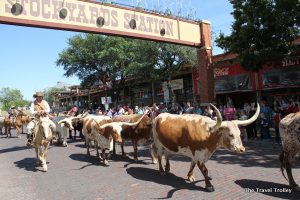The 9/11 Flight Crew Memorial was born out of American Airlines Flight Attendant Valerie Thompson’s desire to honor the crewmembers killed on the planes hijacked on Sept. 11: American Airlines flights 11 and 77 and United Airlines flights 93 and 175. Her dream became reality when the monument was dedicated on July 4, 2008. Based on a design by Bryce Cameron Liston of Salt Lake City, Utah, and sculpted by Dean Thompson, the memorial features bronze sculptures of two pilots, two flight attendants and a child who represents the traveling public. The memorial’s base stands 18 feet tall. The names of crewmembers on the four flights are engraved on slabs of granite surrounding the base.
76051
Baccus Cemetery in Plano, Texas, dates to 1847 when Henry Cook established the cemetery to bury his son, Daniel. The cemetery was initially known as Cook Cemetery. After Cook died in 1862, his daughter, Rachel, acquired the land, and in 1878, she deeded it to Cook’s heirs for use as a cemetery and a church, Baccus Christian Church. While the church was later abandoned, the cemetery, named Baccus Cemetery in about 1915, is still in use.
75024
The 66-acre Dallas Arboretum and Botanical Gardens is located on the southeastern shore of White Rock Lake in East Dallas. Since opening to the public in 1984, the garden has received many accolades from publications including Architectural Digest, USA Today, Fodor’s Travel, Trip Advisor, The Travel Channel and many others. The Arboretum includes many formal and informal garden spaces, world-recognized trial gardens, a concert lawn, picnic areas, food service areas, a gift shop, orientation theater, classrooms and the historic DeGolyer House.
75218
Dealey Plaza is today synonymous with the 1963 assassination of President John F. Kennedy. However, the history of the plaza dates to 1935 when it was dedicated. Named for longtime Dallas Morning News publisher George Bannerman Dealey, the plaza was completed in 1940. Construction of the 15-acre plaza was made possible after the Trinity River was rerouted to prevent flooding in the area. Home to some of the first settlements, Dealey Plaza is sometimes known as the “birthplace of Dallas.”
75202
Fort Worth is often considered to be “where the West begins,” and the Fort Worth Stockyards was once the epicenter of the cattle industry. While still in active use for cattle sales, the historic stockyards attract thousands of tourists looking to climb atop a longhorn for a photo op, watch the twice-daily cattle drives or catch a glimpse of the unabated wild west. The Stockyards are home to a number of museums, including the Texas Cowboy Hall of Fame, the Texas Rodeo Cowboy Hall of Fame and the Stockyards Museum. And, of course, the Grapevine Vintage Railroad.
76164
The George W. Bush Presidential Center opened on April 25, 2013. The centerpiece is a 9/11 exhibit, but it is but one section of the 14,000-square-foot museum that opened to the public last month. In addition, the museum features a full scale replica of the Oval Office, information about life in The White House, President Bush’s two dogs, a collection of autographed baseballs and an exhibit — complete with hanging chads — about the 2000 election in which Bush defeated then Vice President Al Gore.
75205
The Grapevine Calaboose, which derived its name from “calabozo,” the Spanish word for dungeon, was built as the town’s first jail in 1914. The Grapevine City Council authorized its construction in 1909. It was originally located elsewhere in town (on Barton Street) and moved to Heritage Park in 1976, and to its current location in 1994. The jail apparently housed associates of the Barrow Gang. It remained in use until the early 1950s.
76051
The Grapevine Vintage Railroad takes tourists from the small town of Grapevine, a town that cherishes its rugged western appearance and attracts tourists with wine tasting rooms and other merchants along its main street, to the heart of the Old West, Fort Worth. At the stockyards, visitors can climb atop a longhorn for a photo op, watch the twice-daily cattle drives or catch a glimpse of the unabated wild west or visit one of the museums, including the Texas Cowboy Hall of Fame, the Texas Rodeo Cowboy Hall of Fame and the Stockyards Museum. And, of course, the Grapevine Vintage Railroad.
76051










